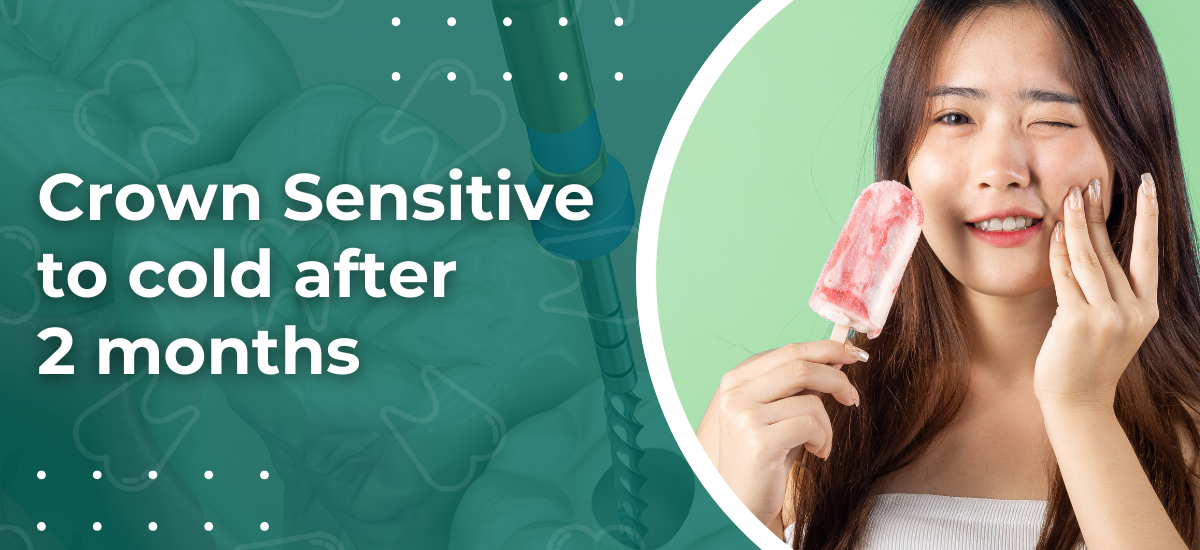Dental crowns are essential for restoring damaged teeth, improving aesthetics, and protecting weakened areas. While they offer long-lasting solutions, some patients may experience unexpected sensitivity to cold temperatures, even two months after the procedure. This sensitivity can raise concerns about the effectiveness of the treatment or signal potential issues needing attention.
Dr. Suhrab Singh, founder of Neo Dental Care, emphasizes:
“Dental crowns play a crucial role in preserving oral health. While sensitivity is common after crowning, it typically subsides within a short time. Prolonged discomfort, however, warrants an evaluation to identify the underlying causes and implement appropriate solutions.”
Dr. Suhrab Singh is among the preferred specialists in Noida for people experiencing dental concerns.
If you’ve noticed lingering cold sensitivity after 2 months, understanding its duration, causes, and prevention is vital to maintaining oral health and comfort.
Is Crown Sensitivity Normal and How Long Does It Last?

It’s normal to experience mild sensitivity to cold or hot stimuli immediately after dental crown placement. This occurs due to:
Nerve irritation: The dental pulp or nerve beneath the crowned tooth might be adjusting to the treatment.
Changes in bite: A slightly uneven bite can cause temporary discomfort.
Adhesive materials: The bonding agents used during crown placement might initially irritate the surrounding tissues.
Typically, this sensitivity resolves within 1 to 2 weeks. However, discomfort can last longer, up to 6 weeks in cases involving complex dental work or pre-existing sensitivity. Persistent sensitivity beyond two months may indicate complications and require professional intervention.
Are you still experiencing cold sensitivity two months after crowning? Schedule a consultation with a skilled dentist to address the issue promptly and ensure optimal oral health.
Let’s delve into the reasons behind crown sensitivity to cold after 2 months.
Crown Sensitive to Cold After 2 Months – Causes

Several factors can contribute to prolonged cold sensitivity in a crowned tooth:
1. Exposed Tooth Nerves
In some cases, the crown may not fully cover the tooth, exposing the underlying tooth or nerves. This can happen due to improper crown placement or wear and tear. This can also create opportunities for decay or infection.
2. Improper Bite Alignment
If the crown is slightly too high or does not align properly with the opposing teeth, it can create excess pressure, leading to discomfort and sensitivity.
3. Residual Infection
If the underlying tooth was not adequately treated before crown placement, residual bacteria can cause inflammation or infection, leading to heightened sensitivity.
4. Material-Related Reactions
Some individuals might have sensitivity or allergies to the materials used in the crown, such as metal alloys or porcelain.
5. Gum Recession
Over time, gums may recede, exposing the tooth’s root and causing sensitivity to cold. This issue is common in aging patients or those with periodontal disease.
6. Structural Cracks or Leaks
A crack in the crown or inadequate sealing can allow cold air or liquids to seep through, irritating the tooth’s nerve.
7. Nerve Damage

In rare cases, the procedure may cause irreversible damage to the tooth’s nerve, requiring a root canal.
Worried about persistent sensitivity under your crown? Consult a dental professional to identify the root cause and explore effective treatment options.
Dealing with cold sensitivity can be challenging, but the good news is there are ways to manage it effectively. Let’s explore some helpful tips.
Tips to Manage Crown Sensitivity to Cold After 2 Months
1. Use Desensitizing Toothpaste
Use toothpaste made for sensitive teeth instead. Potassium nitrate is one of the ingredients that helps relieve pain by blocking pain signals from the tooth’s nerves.
2. Adjust Your Diet
Avoid excessively hot, cold foods, and acidic foods and drinks, which can trigger discomfort. Opt for lukewarm options until sensitivity subsides.
3. Maintain Proper Oral Hygiene
Brush gently with a soft-bristled toothbrush to prevent further irritation around the crowned tooth. Regular flossing can also help prevent gum recession.
4. Use a Mouth Guard

If you grind your teeth at night, consider using a mouth guard. Grinding can exacerbate sensitivity and damage the crown.
5. Over-the-Counter (OTC) Pain Relievers
Acetaminophen and ibuprofen are examples of non-prescription pain medications that can help control discomfort and inflammation.
6. Rinse with Warm Salt Water
A gentle saltwater rinse can soothe irritated gums and promote healing, which may alleviate some of the sensitivity.
7. Visit Your Dentist
If the sensitivity persists, schedule a check-up. Your dentist can adjust the crown’s fit, address underlying issues, or recommend additional treatments as needed.
Don’t let cold sensitivity affect your quality of life. Seek expert advice and regain your confidence in your dental health.
Want to Avoid the Sensitivity Altogether? Keep Reading!
Tips to Prevent Crown Sensitivity to Cold After 2 Months

Prevention is always better than cure. Here are some proactive steps to keep sensitivity at bay:
1. Choose Quality Materials
Opt for durable, biocompatible crown materials that minimize irritation and ensure long-term comfort.
2. Ensure Proper Fit
Work with an experienced dentist who can precisely fit the crown to your tooth and bite, reducing the risk of sensitivity.
3. Use Fluoride Mouthwash
Fluoride strengthens the enamel and minimizes sensitivity. Incorporate a fluoride rinse into your daily routine.
4. Follow Post-Treatment Care Instructions
Carefully adhere to your dentist’s post-procedure guidelines, including avoiding certain foods and maintaining oral hygiene.
5. Address Pre-Existing Conditions
Treat issues like gum disease, decay, or infections before crown placement to prevent complications later.
6. Avoid Overbrushing
Brushing too hard can cause gum recession, exposing the roots of your teeth. Use gentle, circular motions with a soft-bristle toothbrush.
7. Regular Dental Check-Ups
Schedule routine check-ups to ensure the crown remains in good condition and catch potential problems early.
Conclusion
Experiencing cold sensitivity two months after a dental crown placement can be frustrating, but it’s often manageable with the right approach. While some sensitivity is expected during the healing process, you should not ignore persistent discomfort.
Dr. Suhrab Singh, a highly-experienced dentist in Noida, advises:
“Prompt action and regular follow-ups can make all the difference. Identifying the underlying cause early ensures your crown’s comfort and longevity. Don’t hesitate to reach out to a trusted dental professional for guidance.”
Take proactive steps to care for your crowned tooth, and enjoy a healthy, pain-free smile for years.
Still have questions about dental crown sensitivity? Here are answers to common concerns!
FAQs
1. Can cold sensitivity indicate a problem with the crown’s material?
Yes, sensitivity could result from a reaction to the crown’s material, especially metal or porcelain. Your dentist may recommend testing for allergies and switching to a more compatible material if necessary.
2. Is it normal for sensitivity to increase over time?
No, sensitivity should decrease as the tooth and surrounding tissues heal. Increasing sensitivity might signal complications like gum recession or crown misalignment, requiring professional evaluation.
3. Can grinding my teeth make the sensitivity worse?
Teeth grinding, or bruxism, can exert excess pressure on the crown, aggravating sensitivity and potentially causing damage. A custom mouth guard can protect your teeth and alleviate the problem..
4. Should I avoid using the crowned tooth until the sensitivity subsides?
No, avoiding the crowned tooth can lead to an uneven bite and strain on other teeth. Instead, chew gently and on both sides to maintain balance.
5. How often should I visit my dentist after getting a crown?
Regular dental visits every six months are essential to monitor the crown’s condition. However, if you experience prolonged sensitivity or other concerns, don’t wait for your next routine check-up.
Take Control of Your Dental Health! Reach out to a qualified dental specialist for expert advice and solutions tailored to your needs.
Reference Links:
https://www.verywellhealth.com/tooth-sensitivity-after-crown-5210263
https://my.clevelandclinic.org/health/treatments/10923-dental-crowns
Disclaimer: The information shared in this content is for educational purposes only and not for promotional use.

